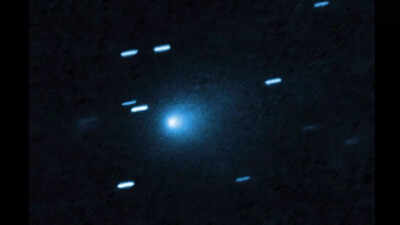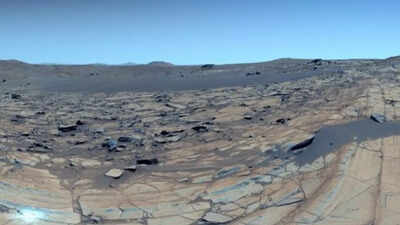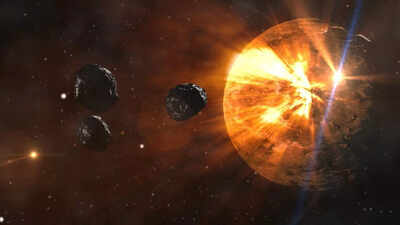NASA’s Hubble Space Telescope In a groundbreaking discovery, has captured the clearest-ever image of 3I/ATLAS, a rare interstellar comet racing through our solar system at an incredible speed of 130,000 miles per hour. Marking only the third confirmed interstellar object ever observed, 3I/ATLAS is offering scientists a once-in-a-lifetime opportunity to examine material formed in an entirely different star system, possibly light-years away in the Milky Way galaxy. Unlike typical solar system comets, this cosmic traveller carries with it the secrets of its alien origins, making it an astronomical treasure. Hubble’s sharp observations are now helping researchers unravel its composition, trajectory, and structure — unlocking vital clues about how other planetary systems may evolve across the galaxy.
NASA detects interstellar comet 3I/ATLAS showing solar system-like behaviour, Hubble Space Telescope confirms
The comet was first detected on July 1, 2025, by the ATLAS (Asteroid Terrestrial-impact Last Alert System), a NASA-funded sky survey designed to detect near-Earth objects. At the time of its discovery, 3I/ATLAS was about 420 million miles from the Sun — far from Earth and posing no danger. However, what makes this event so extraordinary is its origin: 3I/ATLAS is not from our solar system.Its hyperbolic trajectory and high velocity confirm it’s a visitor from another star system, making it only the third interstellar object ever observed after ‘Oumuamua in 2017 and 2I/Borisov in 2019. Using its ultra-precise optics, the Hubble Space Telescope revealed a sunlit dust plume emerging from 3I/ATLAS and the early formation of a dust tail, similar to that seen in typical solar system comets. This glowing halo, or coma, surrounds the comet’s solid core and gives scientists clues about its composition and behavior.Though the actual nucleus — the frozen core of ice and rock — is still hidden beneath the coma and invisible even to Hubble, astronomers estimate its size to be between 1,000 feet (320 meters) and 3.5 miles (5.6 kilometers) in diameter.Interestingly, the comet’s dust-loss rate — a key indicator of activity — appears comparable to that of native solar system comets located roughly 300 million miles from the Sun. This suggests that while 3I/ATLAS comes from another solar system, it behaves much like our own cometary bodies, pointing to potentially shared physical characteristics.
Mysterious origins of 3I/ATLAS
According to NASA, 3I/ATLAS likely originated in a different solar system, possibly billions of years ago. It may have been ejected by gravitational forces during the early formation of a distant planetary system and has since drifted through interstellar space, influenced by countless gravitational encounters with stars and nebulae.“It’s like glimpsing a rifle bullet for a thousandth of a second,” said Dr. David Jewitt, lead astronomer for the Hubble observations and planetary scientist at UCLA. “You can’t trace it back precisely to where it came from.”While its exact origin remains unknown, its discovery is part of a growing body of evidence suggesting there may be a hidden population of interstellar objects silently passing through our solar neighborhood — most undetected until now.
NASA: 3I/ATLAS reveals hidden population of interstellar comets
“This latest interstellar tourist is one of a previously undetected population of objects bursting onto the scene,” Jewitt explained. “We’ve now crossed a threshold in detection capability, thanks to next-generation sky surveys.”In fact, today’s advanced telescopes and space observatories — such as Hubble, James Webb Space Telescope (JWST), TESS, Neil Gehrels Swift Observatory, and Hawaii’s W.M. Keck Observatory — are revolutionizing our ability to detect and study fast-moving interstellar bodies. Each plays a crucial role in capturing critical data on their trajectories, chemical composition, and physical behavior.The ongoing observation of 3I/ATLAS by this array of instruments will allow scientists to analyze its gases, dust particles, and molecular structure, giving us a deeper understanding of how comets evolve in alien star systems.
3I/ATLAS timeline: Visibility and future observations
For space enthusiasts and astronomers alike, 3I/ATLAS will continue to be visible through ground-based telescopes until September 2025. After this, the comet will pass too close to the Sun and become temporarily obscured by solar glare. However, it’s expected to re-emerge in early December 2025, offering another exciting chance to study this interstellar object in motion.
Why 3I/ATLAS matters: Scientific and philosophical implications
While 3I/ATLAS poses no threat to Earth, its significance cannot be overstated. Studying it may help scientists answer some of the most profound questions in astrophysics:How common are interstellar objects in our galaxy?Do other planetary systems produce comets like our own?Can we use these objects as natural probes into the chemistry of distant star systems?Each interstellar discovery pushes the boundary of what we know about the structure and evolution of the Milky Way, and potentially, about the conditions that lead to planetary formation and life.Also Read | NASA warns! Two giant asteroids, one over 300 feet to make close Earth flybys on August 8, 2025; are we really at risk






